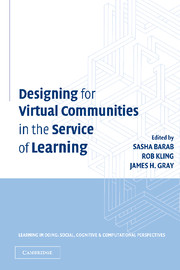Book contents
- Frontmatter
- Contents
- List of Contributors
- Series Foreword
- Foreword
- Preface and Acknowledgments
- In Memoriam
- PART I COMING TO TERMS WITH COMMUNITY
- PART II DESIGNING FOR WEB-SUPPORTED COMMUNITY
- PART III FOSTERING COMMUNITY/MEMBER PARTICIPATION
- PART IV RESEARCHING ONLINE COMMUNITY
- 11 Scholarly Networks as Learning Communities
- 12 Computer-Mediated Discourse Analysis
- 13 Shared “We” and Shared “They” Indicators of Group Identity in Online Teacher Professional Development
- 14 Sociocultural Analysis of Online Professional Development
- Index
- Titles in the series
- References
11 - Scholarly Networks as Learning Communities
The Case of TechNet
Published online by Cambridge University Press: 05 June 2012
- Frontmatter
- Contents
- List of Contributors
- Series Foreword
- Foreword
- Preface and Acknowledgments
- In Memoriam
- PART I COMING TO TERMS WITH COMMUNITY
- PART II DESIGNING FOR WEB-SUPPORTED COMMUNITY
- PART III FOSTERING COMMUNITY/MEMBER PARTICIPATION
- PART IV RESEARCHING ONLINE COMMUNITY
- 11 Scholarly Networks as Learning Communities
- 12 Computer-Mediated Discourse Analysis
- 13 Shared “We” and Shared “They” Indicators of Group Identity in Online Teacher Professional Development
- 14 Sociocultural Analysis of Online Professional Development
- Index
- Titles in the series
- References
Summary
WIRING SCHOLARLY NETWORKS
Rapid developments in computer-mediated communication are associated with a paradigm shift in the ways in which institutions and people are connected. This is a shift from being bound up in small groups to surfing life through diffuse, variegated social networks. Although the transformation began in the pre–Internet 1960s, the proliferation of the Internet both reflects and facilitates the shift.
Much social organization no longer fits a group-centric model of society. Work, community, and domesticity have moved from hierarchically arranged, densely knit, bounded groups to social networks. In networked societies, boundaries are more permeable, interactions are with diverse others, linkages switch between multiple networks, and hierarchies are flatter and more recursive. People maneuver through multiple communities, no longer bounded by locality. They form complex networks of alliances and exchanges, often in transient virtual or networked organizations (Bar & Simard, 2001). Workers – especially professionals, technical workers, and managers – report to multiple peers and superiors. Work relations spill over their nominal work group's boundaries and may even connect them to outside organizations. In virtual and networked organizations, management by network has people reporting to shifting sets of supervisors, peers, and even nominal subordinates (Wellman, 2001).
How people learn is becoming part of this paradigm shift. There has been some movement away from traditional classroom-based, location-specific instruction to online, virtual classrooms. There has also been some movement away from teacher-centered models of learning to student-centered models and flatter hierarchical relations. Physically dispersed learning is part of this shift.
- Type
- Chapter
- Information
- Designing for Virtual Communities in the Service of Learning , pp. 299 - 337Publisher: Cambridge University PressPrint publication year: 2004
References
- 12
- Cited by



